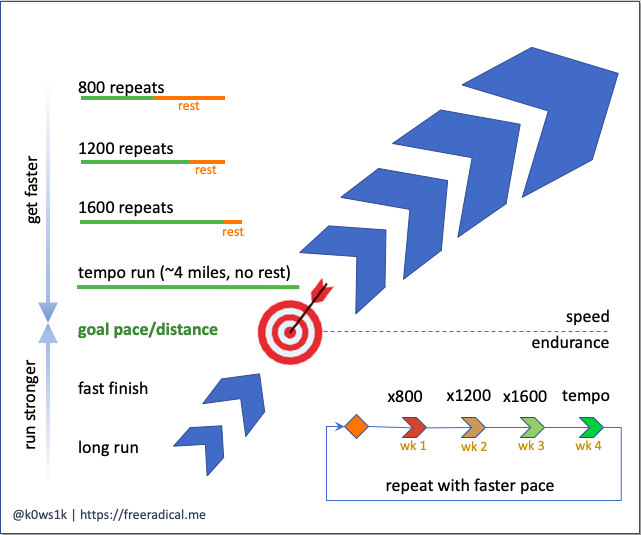In the last 10 years, I’ve run 91 ultra marathons (50K or longer) and 11 official marathons 😳, during which speed was a nice side-effect, never the goal. And yet, when I finally attempted in earnest to BQ (which I did at Jack & Jill Marathon), and looked around for marathon training ideas/plans to get faster, all I got were buzzwords: VO2Max, Fartleks, Intervals, Threshold runs, Hill strides, etc. What was missing for me personally, was how to layers these drills so they build on each other to help me get faster during marathon training. This blog is NOT a marathon training plan, but a strategy on pushing the body in the right direction & cadence to get faster. YMMV.
Marathon Training – The Obvious
Okay, let’s get the obvious out of the way. This blog assumes you already know how to run a marathon or some such long distance. It’s about getting faster in a consistent, methodical way.
- You only get faster by learning to run fast (duh!)
- Having “fun” runs day in and day out won’t make you faster. You have to build in speed workouts that will gradually carry over to the long runs
- Having “fun” runs day in and day out won’t make you faster. You have to build in speed workouts that will gradually carry over to the long runs
- A 10 second increase per-mile, is a LOT
- Basic math – a 10 second speedup per-mile is 4:20 over 26.2 miles
- That would be a make or break for a BQ
- Body’s adaptation to speed takes time
- You may not notice getting faster week-over-week. But stay consistent and your body will adapt. You’ll even notice your long runs at a given pace getting easier, faster. So celebrate the incremental week-over-week gains
- However, do follow the 10% rule on both the distance and the pace increases. The muscles, bones and tendons take time to get stronger
- You can’t get faster beyond a certain peak age (I’m 51 and I know this window is shrinking)
- This is just aging doing its thing. Exactly when someone peaks is going to differ and so is how long they can hold on to that peak speed before slowing down.
- What has been observed which I’m also hoping is, barring any injuries, the endurance and ability to run far will stay well past this peak age
Getting Faster – Intervals to Long Runs
The overall strategy is to bookend the goal pace/distance runs with speed and endurance. The speed workouts incrementally build on each other making the goal pace runs faster. The endurance workouts adapt your body to get comfortable with the goal distance, while benefiting from the overall speed increase. The net result is your goal pace AND distance moves up and to the right over time, allowing you to run faster for longer. The following picture illustrates this idea:

My overall marathon training for the BQ was broken down to a weekly ritual of one speed workout, one long run, 3 days of easy trail runs (that meant no Strava achievements!) and 2 days of rest. But the sequencing of the week-over-week, interspersed speed workouts were the most critical for the BQ. Here’s an example:
- Week 1 – run 10x 800’s at, say, 8:00 min/mile pace. That would be 4:00 minutes for two laps, followed by 4:00 minutes of relaxed jogging
- Week 2 – run 8x 1200’s at the same 8:00 min/mile pace. That’s 6:00 minutes for three laps, followed by 2:00 minutes of relaxed jogging
- Week 3: run 6x 1600’s (mile) at the same 8:00 min/mile pace. That’s 8:00 minutes for four laps, followed by 1:00 minute of relaxed jogging
- Week 4: after a warm up, run ~4 miles a little slower than 8:00 min/mile pace (without any rest) and then cool down
- Now here’s the kicker and prolly the most important thing that worked for me. After week 4, increase the pace by, say, 10s and start all over at Step 1 at a 7:50 min/mile pace and follow through.
By the third cycle (week 9), I was seeing noticeable improvements. My 800s had started out at 7:00 min/mile and I was now pushing a 6:15 min/mile pace, pretty comfortably at that too. This exact same speed workout carries on the endurance side of the training too, especially for the fast finish runs. These runs weren’t nearly as far as the long runs, but the last mile or two always ended with a pace that was at or near the tempo run pace. For the final push in the last few miles of the marathon, mentally and physically, this helped a lot to sustain the pace and get me the BQ.
As I wrote on the last blog, I feel like this is a process that can help me get from 3:17 to 3:10. I can see a clear path forward with focused, week-over-week progress in speed. If you think this works for you or makes sense, I would love to hear from you! Leave a comment below.
Thanks to Rohit and Erin for looking over the draft of this blog.
Absolutely N.O. spam. No more than two emails each week. Learn about injury-free running, race reports, new trail routes, awesome recipes and amazing interviews.